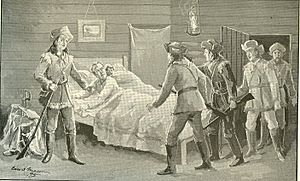Philippe-François de Rastel de Rocheblave facts for kids
Quick facts for kids
Philippe-François de Rastel de Rocheblave
|
|
|---|---|

Philippe de Rocheblave, the commandant of Fort Gage, captured in bed, with his wife, by Colonel George Rogers Clark and the Illinois Regiment, Virginia State Forces, in 1778, who seized the lightly guarded British outpost, of Kaskaskia, in the Illinois Country
|
|
| Born | March 23, 1727 Savournon, Hautes-Alpes, France
|
| Died | April 3, 1802 |
| Nationality | French, Canadian |
| Other names | Philippe de Rocheblave, Chevalier de Rocheblave |
| Occupation | soldier, colonial army officer, trader, colonial militia officer, fur trader, politician |
| Spouse(s) | Marie Louise Dufresne |
| Children | Noël de Rastel de Rocheblave (son), Pierre de Rastel de Rocheblave (son) |
| Parent(s) | Jean Joseph de Rastel de Rocheblave and Diane Elizabeth Dillon |
| Relatives | Jacques Michel du Fresne (father-in-law), Marie Francoise Henry (father-in-law) |
Philippe-François de Rastel de Rocheblave (March 23, 1727 – April 3, 1802) was a soldier and businessman. He was also known as Philippe de Rocheblave or the Chevalier de Rocheblave. He lived in a region called the Illinois Country in North America. Later, he became an important political figure in Lower Canada.
Contents
Early Life and Military Service
Philippe-François de Rastel de Rocheblave was born in Savournon, a town in Hautes-Alpes, France.
He joined the French Army and served in New France. This was during a big conflict known as the Seven Years' War. In North America, this war was also called the French and Indian War.
Rocheblave was a lieutenant at Fort de Chartres in the Illinois Country. This fort was an important French outpost.
Life in the Illinois Country
After his military service, Rocheblave started a business in Kaskaskia. Kaskaskia was a busy trading town.
When the British took control of Kaskaskia, Rocheblave moved. He became the leader, or commandant, of Fort Sainte-Geneviève. This fort was in the Illinois Country but controlled by Spain.
In 1774, Rocheblave returned to Kaskaskia. He became the commandant there, but this time for the British.
American Revolutionary War Role
In 1778, the American Revolutionary War was happening. Colonel George Rogers Clark led American forces. His group, the Illinois Regiment, was part of the Virginia Defense Force.
Clark's forces captured Kaskaskia from the British. They took Philippe de Rocheblave as a prisoner of war.
Rocheblave was sent to Virginia. He managed to escape and then joined the British forces in New York City.
Life After the War
After the American Revolutionary War ended, Rocheblave first moved to Upper Canada. This area is now part of Ontario.
He was approved for a large piece of land near the Humber River. However, getting the land officially took a long time.
Philippe de Rocheblave then moved his family to Montreal. In 1789, they settled in Varennes. He also became involved in the fur trade near Detroit.
In 1796, Rocheblave was elected to the Legislative Assembly of Lower Canada. This was a governing body for the region. He was re-elected two more times, serving until his death.
His sons, Noël and Pierre, also became members of the legislative assembly. Pierre also joined the Lower Canada Legislative Council.
Philippe de Rocheblave died on April 3, 1802, in Quebec City, Lower Canada.
Images for kids


